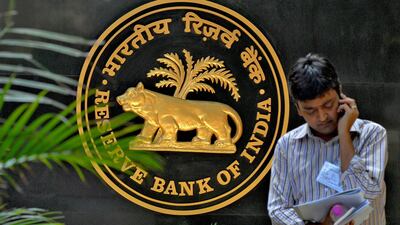India’s central bank cut its key interest rate for a fifth straight time this year, moving aggressively to revive economic growth as the banking system faces new stresses.
The Reserve Bank of India lowered its benchmark repurchase rate by 25 basis points to 5.15 per cent on Friday. A majority of the 39 economists in a Bloomberg survey predicted the move, while the rest forecast cuts ranging from 15 basis points to 40 basis points.
The Monetary Policy Committee will “continue with the accommodative stance as long as it is necessary to revive growth while ensuring inflation remains within the target,” governor Shaktikanta Das told reporters in Mumbai.
The entire six-member Monetary Policy Committee voted for a rate cut. One member voted for a 40 basis-point cut, while the others opted for a quarter-point easing. The RBI retained its accommodative policy stance.
Mr Das last month alluded to the chance of more easing, given concerns about economic growth. The RBI on Friday lowered its full-year growth forecast for a fourth time, to 6.1 per cent from 6.9 per cent previously.
The benchmark stock index and the rupee pared gains after the decision, while India’s 10-year bonds fell, as some investors had expected a bigger cut.
The market reaction reflects “over-exuberance about bigger rate cuts getting dented,” said Naveen Singh, head of fixed-income trading at ICICI Securities Primary Dealership in Mumbai. There’s also some disappointment that the governor himself voted for just a 25 basis-point cut, he said.
Central banks around the world are loosening monetary policy to offset a global slowdown made worse by US-China trade tensions. Australia cut rates earlier this week for the third time this year, while the Philippines and Indonesia eased policy last month.
India's economy grew 5 per cent in the quarter ended June, the weakest pace in six years. Leading indicators tracked by Bloomberg News suggest fairly subdued investment and consumption activity in August.
Friday’s cut takes the benchmark rate to the lowest in almost a decade and follows a number of recent fiscal steps taken by the government to spur growth, including a surprise $20 billion reduction in corporate taxes.
“While the recent measures announced by the government are likely to help strengthen private consumption and spur private investment activity, the continuing slowdown warrants intensified efforts to restore the growth momentum,” the central bank said.
The cut takes the cumulative easing so far this year to 135 basis points, prompting economists to question how much more easing room the RBI has.
“I think they have done enough and, given a considerable policy transmission lag, they should allow the easing so far to bear fruit,” said Prakash Sakpal, an economist at ING Groep in Singapore. “Or else, the authorities are running the risk of aggressive fiscal and monetary pump-priming eventually fueling inflation.”
The RBI is also facing mounting problems in the banking system, which could further hurt lending in the economy. It recently imposed withdrawal curbs on a small bank and lending restrictions on another lender.
Mr Das reiterated on Friday that the banking system “remains sound and stable,” and there’s no reason for “unnecessary panic.”
The central bank raised its near-term inflation forecast slightly to 3.4 per cent for the second quarter of the fiscal year started April, while projecting it would stay below its medium-term target of 4 per cent -- a level it has undershot for 13 straight months.

